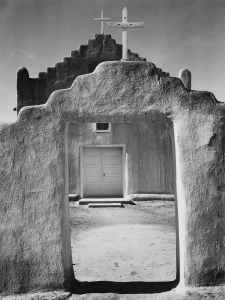A Theology of Photography

When it comes to landscape photography, there is perhaps no one better known to the general public than Ansel Adams, and I gladly list him as a primary inspiration of mine. But in addition to Adams, I would like to mention two other photographers who have greatly impacted my work and approach to the craft: John Sexton, and Minor White. In presenting my inner approach to photography, a brief discussion of these three figures has direct bearing on the merits of The North American Thebaid Photographic Pilgrimage Project.
Ansel Adams was a towering figure in photography, a technical master of composition, exposure, developing and printing, with a highly refined sense of light. However, Minor White, while less well known to the general population, had (I believe) a deeper, more philosophical and even spiritual approach to photography than Adams, as this quote of his reveals:
While we cannot describe its appearance (the equivalent), we can define its function. When a photograph functions as an Equivalent we can say that at that moment, and for that person the photograph acts as a symbol or plays the role of a metaphor for something that is beyond the subject photographed… One does not photograph something simply for “what it is”, but “for what else it is”. (Source, emphasis in original.)

One biographer of White notes that “White was a deeply religious man whose whole life was a spiritual journey. His photography arose out of this and was an inherent part of this pilgrimage. It isn’t an approach that has been fashionable in academic circles in recent years.” (Emphasis added.)

White worked with Ansel Adams for a number of years, as did John Sexton, who was one of Adams’ last assistants, and who has gone on to create a unique and evocative body of work in establishing himself as one of the great contemporary photographers. Building on Ansel Adams’ technical foundation, Sexton has charted his own course, and in a manner reminiscent of Minor White, has articulated a deeply sensitive photographic aesthetic, conveyed in his memorable books, Quiet Light, Listen To The Trees, Places of Power, and Recollections.
In my own work, I too have been inspired by Ansel Adams, but feel I have followed more in the philosophical-spiritual footsteps of Minor White and John Sexton in forming my own Orthodox Christian photographic aesthetic. In the Preface to my 40-year photographic retrospective book, ‘Pursuing the Light’, I present my “theology of photography” as follows:
I have come to believe that to “draw with light” [the literal meaning of the word, “photography”] is to take part in the mystery of the cosmos itself. After all, light was created on the first day (Genesis 1:3).
Thus the artist who interprets and shares the beauty of creation, who uses light to share Light, is in some humble way partnering with the Master Artist. He is co-working with the Word of God through Whom light and all things came to be. In sharing his images with the viewer—the Other—the photographer quietly, gently, contributes to an essential aspect of human life, that of relationship, community, or more theologically, communion.
So the creation and sharing of beautiful images speaks to the soul of the viewer, hopefully instilling and nurturing beauty, peace, harmony, balance. And in doing so, the photographer/artist is glorifying God.
Is this not what the Psalmist ecstatically cries out when considering the starry sky?
The heavens are telling the glory of God; and the firmament proclaims his handiwork. Day to day pours forth speech, and night to night declares knowledge. There is no speech, nor are there words; their voice is not heard; yet their voice goes out through all the earth, and their words to the end of the world. — Psalm 19:1-4, NRSV
Somehow, in stillness, through silence, photography can speak words of beauty, light, truth and love. And yet, in considering this mystery of light and beauty, and why fine images stir our souls with longing, we may suggest another possibility:
Perhaps it is not not merely we who pursue light.
Perhaps it is the Light which pursues us.

Thus this proposed project grows out of a holistic Orthodox ethos, a gestalt which, for me, finds its expression through fine photography. It is my fervent desire to devote myself to this endeavor, using the talent given me to help the Church in “expanding the mission.”
I hope these considerations inspire you to support The North American Thebaid Photographic Pilgrimage Project, with your blessings, prayers, and if at all possible, with some tangible means to enable this good work to proceed.
With humble thanks…
in Christ,
Ralph H. Sidway (zosimas)
October 2015

Pingback: OCA Monastic Synaxis looks to ‘Creative Methods’ to Nurture Vocations | The North American Thebaid
Pingback: NEW, BONUS PERK for Crowdfunding Supporters – The North American Thebaid
You make some good points. It’s never occurred to me that there can be such a solid theological foundation for photography. I’m also reminded of those psalms that glorify God the Creator by picturing (with words, not light) the beauty and richness of Creation.
Incidentally, grapho in modern Greek means both to write and to draw. They are the same in ancient Greek, but the infinitive form of the verb is different (and I don’t know it).
LikeLike